pyschology courssework
1/334
There's no tags or description
Looks like no tags are added yet.
Name | Mastery | Learn | Test | Matching | Spaced |
|---|
No study sessions yet.
335 Terms
What is stress
Stress is a psychological and physiological experience that occurs when an individual encounters a situation or demand that is significant and requires coping. It arises from the interaction between the individual and their environment, activating both cognitive processes (such as appraisal of the situation) and biological responses (such as hormone release).
What is a stressor
A stressor refers to any stimulus (internal or external) that triggers the stress response. It can be physical, social, psychological, or environmental and varies in significance depending on the individual's perception.
What is an internal stressor
An internal stressor originates from within the individual's body or mind. It may arise from cognitive factors, such as how one perceives or interprets a situation, or biological factors, such as illness or hormonal imbalances. These stressors are rooted in the person's thoughts, feelings, or physiological states.
Give examples of internal stressors
Attitude: A negative attitude, this could make it more likely that they consider a situation to be outside of their capacity to cope, increasing the likelihood of experiencing stress. Rumination: The repetitive focus on negative thoughts or events, which prevents the individual from moving past stress-inducing situations and often amplifies emotional distress.Low self-esteem: A lack of confidence in one's abilities, which leads individuals to doubt their capacity to overcome stressful situation, resulting in increased likelihood of experiencing anxiety or worry Nervous system dysfunction: Abnormalities in the regulation of the nervous system, often due to conditions like neurotransmitter imbalance such as gamma-amino butyric acid (GABA), could make it more likely to experience a stress response. An insufficient neural transmission of GABA can lead to the over-excitation of neurotransmitters and make it difficult to regulate the stress response and impair the body’s ability to cope.
What are external stressors
An external stressor comes from outside the individual and involves stimuli from the environment or social situations that prompts the stress response. External stressors come from our interaction with the world around us, not the cognitive or affective processes that impact how we perceive stressful events.
Give an example of external stressors
A test or an exam Meeting new people Arguments with friends and/or family members Working long hours Financial difficulties
Do external and internal stressors work in isolation and give an example where they work in tandem.
External and internal stressors rarely function in isolation; they often interact, compounding their effects on an individual. An external stressor originates from environmental circumstances, such as meeting someone new at a party. Internally, an individual might focus on negative thoughts about what could go wrong in this social interaction. The combination of external pressure (the social event) and internal cognitive processes (worry and anxiety) amplifies the overall stress response.
Explain the psychological and physiological components of stress.
Stress includes both psychological processes that are unique to each individual and physiological processes that are mostly common to all.Explain the psychological components of stress.The psychological aspect of stress refers to the cognitive and emotional processes that occur when an individual perceives a stressor. It demonstrates the subjective nature of stress and how experiences vary between individuals, depending on the perception and appraisal of the stressor. For example, a school exam may be seen as a source of anxiety for some, while others may interpret it as a challenge or an opportunity, depending on their cognitive appraisal of the situation.Explain the physiological components of stress.The physiological aspects of stress refer to the biological processes that occur when an individual perceives a stressor. These responses are considered objective because they are largely uniform across all individuals, meaning they follow similar patterns regardless of personal experience or subjective interpretation. For example, when watching a horror movie, most people experience a noticeable increase in heart rate during frightening moments. This is a physiological response driven by the nervous system, particularly the autonomic nervous system.
What is distress and give an example
Distress is a form of stress characterised by a negative psychological state. Distress often occurs when a stressor presents an individual with an undesirable circumstance that appears to lead only to a negative outcome. When a person loses the keys to their car, they often experience distress. Losing car keys is likely to cause somebody to be late to their commitments, or even become a financial burden if the keys need to be replaced. As a result, emotions like worry and frustration occur as the individual contemplates the major inconveniences brought about by not finding their keys.
What is eustress and give an example
Eustress is a form of stress characterised by a positive psychological state. Eustress involves positive emotions, such as feeling inspired and motivated, and tends to occur when the stressor provides a positive opportunity or circumstance for the individual. For example, being offered a place at university can be stressful in that it demands change and effort, but it often results in positive emotions, such as feeling motivated and excited for personal growth.
Explain objective and subjective stressors.
The psychological components of the stress response, including eustress and distress, demonstrate the subjective nature of stress. This means that psychological stress responses will be experienced differently by different people, depending on their individual perception of the stressor. By contrast, physiological stress responses are often referred to as being objective as they are largely uniform across all individuals, meaning they follow similar patterns regardless of personal experience or subjective interpretation.
Compare eustress and distress in terms of performance and functioning
Eustress enhances performance and functioning, encouraging motivation and focus. It often leads to higher productivity and engagement, particularly in situations that require personal growth or problem-solving.Distress can also boost performance initially, however, if it becomes overwhelming, it may lead to a breakdown in coping mechanisms, resulting in reduced efficiency and impaired decision-making. Excessive distress can cause burnout and long-term emotional and physical health consequences.
What is acute stress
Acute stress is a form of stress characterised by intense psychological and physiological responses that are brief in duration. It typically arises in response to an immediate threat or challenge that demands rapid action for the organism's survival. In such situations, the body engages in a quick, adaptive response by activating its physiological systems, primarily through the autonomic nervous system.
What is the Flight-Fight-Freeze response
The fight-flight-freeze response is an automatic, involuntary reaction to a perceived threat, which prepares an organism to either confront the danger (fight), escape from it (flight), or become immobile (freeze). This physiological response is triggered by acute stressors and is deeply rooted in survival mechanisms.
What are the physiological characteristics of flight
Fleeing from the stressor: In the flight response, an organism instinctively retreats from the perceived threat. This behaviour arises from the assessment that escape represents the safest option for survival.Sympathetic nervous system activation: The flight response is primarily mediated by the sympathetic nervous system, which activates a cascade of physiological changes to prepare the body for rapid movement.Adrenaline Release: The adrenal glands secrete adrenaline, leading to various physiological changes such as increased heart rate, heightened respiratory rate, and enhanced energy production. This enables the body to swiftly escape from the danger.
What are the physiological characteristics of fightConfronting the Stressor: In the fight response, an organism confronts and engages with the perceived threat directly. This reaction is rooted in the belief that facing the danger is necessary for survival.Activation of Sympathetic Responses: The sympathetic nervous system triggers a series of physiological responses that energize the body, preparing it to deal with the imminent danger.Release of Adrenaline: Like the flight response, adrenaline is released from the adrenal glands, which facilitates increased strength, speed, and endurance, allowing the organism to effectively confront the threat.
What are the physiological characteristics of freeze
Immobilization and Shock: The freeze response is characterized by a temporary state of immobility and shock. This reaction occurs when the stressor appears overwhelmingly threatening, leading the body to become physically 'frozen' as it assesses the situation.Inability to Respond: The freeze response may emerge when an organism feels it lacks the energy or time to either fight or flee. This can result in a momentary paralysis as the body processes the stressor.Survival Strategy: Remaining still can sometimes be the most effective strategy for survival, as it may prevent detection by predators. For example, prey animals often remain motionless when they sense a nearby threat.Activation of the Parasympathetic Nervous System: Initially, the freeze response involves a brief activation of the parasympathetic nervous system, which can result in a decrease in physiological arousal, such as lowered blood pressure and heart rate.Dual Nervous System Activation: Interestingly, the freeze response can also involve simultaneous activation of the sympathetic nervous system, allowing for a rapid transition to either the flight or fight response when necessary. This dual response mechanism enables quick adaptation to changing threats, although the freeze state itself is typically short-lived, lasting only seconds.
What is chronic stress
Chronic stress is a form of prolonged stress that endures for several months or longer resulting in long term physiological arousal, which can negatively impact physical and psychological health. For example, this could include a school year, which can often cause lasting stress throughout the year as students try to balance studying for tests/exams with social activities, work, and interests outside of school.
What is cortisol
Cortisol is a hormone that is released in times of stress to aid the body in initiating and maintaining heightened arousal. It is released by the adrenal glands and is involved in both short-term and longer-term responses to stress. During the flight-or-fight-or-freeze response, cortisol helps to energise the body by inducing the release of glucose and a rise in blood-sugar levels.
What happens when stress is long-term and has high cortisol levels in bloodstream
Cortisol can suppress the immune system. Over time, the body’s energy stores become depleted, and the immune system weakens, leaving the individual vulnerable to infections, illnesses, and other health issues. In addition to suppressing the immune system, chronic stress can lead to long-term changes in metabolism, cardiovascular function, and mental health, potentially contributing to conditions such as anxiety, depression, and heart disease.
RESPONSES TO ACUTE STRESS
Cortisol is released in response to an immediate threat, serving to energize the body. It induces the release of glucose and raises blood sugar levels, providing the necessary fuel for rapid physical responses
The fight response involves confronting the stressor directly. This physiological reaction prepares the body for immediate action
The flight response involves the organism to flee from danger. The body’s physiological state is geared towards quick movement,
The freeze response occurs when the individual is immobilized, typically in situations perceived as overwhelmingly threatening.
RESPONSES TO CHRONIC STRESS
In contrast to the brief release during acute stress, chronic stress leads to a sustained elevation of cortisol levels. Prolonged exposure to high cortisol can be detrimental, resulting in various health issues.
Chronic stress maintains elevated blood sugar levels over time, which can contribute to insulin resistance and metabolic disorders if not properly regulated.
Although chronic stress can result in a state of persistent arousal that eventually leads to fatigue, as the body struggles to cope with constant physiological demands.
Chronic stress can significantly suppress the immune system's functionality, increasing vulnerability to infections and diseases.
STRESS AS A BIOLOGICAL PROCESS
Stress is a psychobiological process, meaning the stress response involves both psychological and biological aspects. Biological processes are physiological processes such as immune system functioning, release of hormones.
What is the General Adaptation Syndrome (GAS)
Selye’s General Adaptation Syndrome (GAS) is a biological model that outlines three distinct stages of physiological reactions experienced by an individual in response to persistent stressors. This model offers a biological perspective on stress, illustrating how the body reacts to challenges over time.
What did Hans Selye do
Hans Selye identified a predictable pattern of physiological responses that an individual endures when experiencing stress. He developed the GAS, which is a model of stress that reflects this biological pattern through three stages: alarm reaction, resistance, and exhaustion. Selye proposed that individuals progress through these stages sequentially when exposed to a stressor.
What is the first stage of the GAS model
The first stage of Selye’s General Adaptation Syndrome (GAS) is known as the alarm reaction. This stage involves an initial decrease in bodily arousal, followed by a subsequent increase in response to an immediate stressor. This stage occurs when an individual first encounters and becomes aware of a stressor. The alarm reaction stage is divided into two substages: shock and counter shock.
What are the first substages of the Alarm stage in GAS
The first substage of the alarm reaction is known as shock. This phase occurs immediately following an individual’s initial exposure to a stressor, during which the body experiences a brief period of decreased bodily arousal. In this state of shock, physiological responses such as heart rate and blood pressure drop below normal levels, impairing the individual's ability to effectively manage or respond to the stressor. This period of shock is temporary, typically lasting only a few moments to minutes, and signifies the body’s initial struggle to cope with the sudden threat. After this, the individual progresses to the next substage of shock.
What are the second substages of the Alarm stage in GAS
Counter shock is the second substage of the alarm reaction stage. In this phase, the activation of the sympathetic nervous system triggers a cascade of physiological responses aimed at preparing the body to confront or escape from the stressor. Adrenaline and other stress hormones are released into the bloodstream, resulting in increased heart rate, elevated blood pressure, and heightened alertness. This surge in bodily arousal signifies a shift from the immobilization of shock to a proactive stance against the stressor. As a result, the individual’s capacity to deal with the stressor significantly increases, marking the beginning of enhanced resistance to stress. This phase sets the stage for the subsequent resistance stage, where the body continues to adapt to the stressor.
What is resistance stage of the GAS model
The second stage of Selye’s General Adaptation Syndrome (GAS) is called resistance. During this stage, the body strives to maintain elevated levels of physiological arousal in response to persistent stressors. The physiological changes initiated during the alarm stage such as increased heart rate, blood pressure, and cortisol levels become sustained as the body adapts to the ongoing stress. This stage is considered adaptive, allowing individuals to cope with the stressor effectively. However, while the body remains in a heightened state of alertness, this prolonged activation can lead to decreased resistance to additional stressors and potential suppression of the immune system due to the continuous presence of cortisol. While the individual copes with the primary stressor during resistance, bodily resources are utilized at an increased rate, eventually leading to the depletion of resources and progression to the third stage of GAS.
What is the exhaustion stage in the GAS model
The third stage of Selye’s General Adaptation Syndrome (GAS) is exhaustion. In this stage, the prolonged exposure to the stressor has led to significant depletion of energy levels and bodily resources, resulting in the individual’s inability to cope with the stressor effectively. By the time a person has entered exhaustion, exposure to the stressor has been prolonged and persistent. The body has been required to maintain a heightened physiological state for as long as the stressor has been present, which is now an extended period. Therefore, levels of bodily arousal and the ability to deal with the stressor decrease too below normal. Individuals experiencing exhaustion may find themselves overwhelmed, unable to cope with the demands of the stressor, and ill-prepared to handle any new stressors that may arise. This phase poses serious health risks, as the continuous presence of stress hormones like cortisol can lead to increased vulnerability to both physiological and psychological illnesses.
What are the effects of exhaustion
When a person enters exhaustion, cortisol and other stress hormones have been present in the bloodstream for a prolonged period of time, suppressing immune system functioning. Therefore, a person in exhaustion becomes vulnerable to both physiological and psychological illnesses. They may experience extreme fatigue, high blood pressure, sickness, anxiety, depression, or emotional instability. They are also more susceptible to serious chronic conditions, such as cardiovascular disease.
What the strengths of the GAS model
The GAS recognises a predictable pattern of physiological responses associated with distinct stages and substages, which can be measured in individuals. This structure helps in understanding the stress response across various contexts and situations.The GAS model highlights the link between chronic stress and the onset of illness. It illustrates how prolonged exposure to stressors can lead to significant health issues, emphasizing the importance of managing stress effectively.The GAS provides scientifically measurable and objective data about the biological processes involved in the stress response. This empirical basis enhances the model's credibility and utility in both research and clinical settings, allowing for better assessments and interventions.
What are the limitations of the GAS model
The GAS model is based on research that was conducted on rats meaning the biological and behavioural differences between species may result in significant variations in how stress is experienced and managed, limiting the generalisability of the model to the human population. The GAS model emphasizes the physiological response to stress, it overlooks the critical psychological factors that can influence an individual's reaction. Emotions, cognitive interpretations, and social contexts play a vital role in how stress is perceived and managed.The GAS model presents a standardized framework for stress reactions, implying that all individuals respond in the same way to similar stressors. However, stress is inherently subjective; factors such as personality, previous experiences, and coping mechanisms can result in varied responses to stress. This limitation highlights the model's inability to account for individual differences in stress perception and reaction.
Explain the Lazarus and Folkman's Transactional Model of Stress and Coping
Lazarus and Folkman’s Transactional Model of Stress and Coping proposes that stress is a subjective ‘transaction’ between an incoming stressor and the personal and environmental factors specific to an individual. It emphasizes that stress is not solely a result of the stressor itself but depends on the individual’s cognitive appraisal (evaluation of stimuli) of the situation and their perceived ability to manage or cope with it. This subjective transaction between the person and the environment explains the variability in stress responses, where the same stressor may elicit different reactions from different individuals based on their unique appraisals and coping resources.
Explain primary appraisal.
In the primary appraisal stage, the individual makes an initial evaluation of the incoming stimulus to determine whether it poses a potential threat to their well-being. This cognitive process involves a rapid assessment of the nature of the stimulus and its potential impact on the individual’s goals, values, and personal resources. There are three initial ways an incoming stressor can be appraised.
First substage: Is this stressful?
Benign-positive: An initial appraisal of a stimulus as neutral or good that does not cause stress for the individual.
Irrelevant: The initial appraisal of stimulus as a lack of meaningful impact on the individual’s well-being and is thus disregarded.
Stressful: An initial appraisal of a stimulus as a source of worry or emotional significance for the individual
The transaction continues only if this initial component of primary appraisal evaluates an incoming stimulus as ‘stressful’. Otherwise, the incoming stimulus is disregarded.
Second substage: What type of stress is causes?
Harm/loss: A further appraisal of a stressor as having caused some damage to the individual. This means the individual has already experienced direct distress as a result of the stressor.
Threat: A further appraisal of a stressor as potentially causing damage to the individual in the future. This appraisal causes the individual to experience distress and induces anxiety, even if the stressor has not directly caused distress yet.
Challenge: A further appraisal of as an opportunity for growth or mastery. Although demanding, the situation is perceived as providing a chance to gain personal development or accomplish something positive
Explain secondary appraisal
In secondary appraisal, the individual decides what types of coping mechanisms or strategies will be needed to confront a stressor, and whether or not these are available to them. The two different kinds of coping strategies individuals may use to deal with a stressor.
Emotion-focused coping: The use of coping strategies to manage the emotional distress associated with the
Wishful thinking: A cognitive strategy where an individual hopes for a positive outcome without taking direct action to address the stressor. (Hoping the situation will resolve itself)
Denial: The refusal to acknowledge the reality of a stressor, minimizing its significance or impact to avoid emotional distress. (Claiming the stressor will not affect you)
Reframing: The process of changing one's perspective on a stressor to see it as an opportunity for growth or improvement, rather than a threat.
Optimism: A mental attitude where an individual expects positive outcomes, believing that the situation will improve over time.
Venting emotions: The expression of feelings like frustration or anger to reduce emotional tension, often through talking to others.
Distraction: The use of activities, such as exercise or hobbies, to divert attention from a stressor, reducing immediate emotional distress (though it can be maladaptive if harmful behaviours, like substance abuse, are used).
Problem-focused coping: The use of coping strategies that actively confront and mitigate the source of the stressor, aiming to reduce it in a practical way. This is most effective when the stressor is perceived as controllable, and the individual has the necessary resources to address it.
Seeking information or advice: Actively looking for guidance or knowledge from professionals or knowledgeable individuals to better understand and address the stressor
Taking action: Implementing concrete steps to tackle the stressor directly, such as committing to a specific study schedule to prepare for an upcoming exam.
Time management: The process of organizing and planning how to allocate time effectively in order to prioritize tasks related to the stressor, such as developing a study timetable to ensure adequate preparation.
How are both emotion and problem focused coping important
Both emotion-focused and problem-focused coping strategies are essential in the stress management process. In situations where the individual has limited control over the stressor (e.g., terminal illness or unexpected tragedies), emotion-focused coping may provide the necessary emotional support and reduce psychological distress. On the other hand, in scenarios where the individual has the capacity to address the source of stress (e.g., academic challenges), problem-focused coping is the more adaptive and effective approach. The simultaneous use of both coping strategies allows the individual to manage the immediate emotional impact of the stressor while also working toward a long-term resolution. This flexibility enhances resilience and prevents chronic stress.
What is reappraisal
Reappraisal occurs when the circumstances about the original stressor changes and so involves a reassessment of the nature of the stressor and coping resources required. This process is dynamic and iterative, meaning that individuals may continually reassess the stressor as new information becomes available or as their resources change. For example, if an upcoming exam is extended to a later date, a person might reappraise the stressor as irrelevant. It allows individuals to adjust their coping strategies as the situation evolves, maintaining an adaptive response to the stressor.
What are the strengths of the Lazarus and Folkman’s model
The model acknowledges the subjective nature of stress and recognizes that stress is not a universal experience, but instead varies based on individual perceptions. This allows for individual variability in stress responses based on personal appraisals and coping resources.The model incorporates cognitive appraisal, which emphasizes the psychological component of stress and highlights the importance of thought processes in stress management. It underscores how an individual’s interpretation of a stressor is crucial in determining their response.The model was developed using data from human studies, which increases its relevance and generalisability in explaining real-world stress responses to the human populationIt explains why individuals respond differently to the same stressor, based on cognitive appraisals and coping mechanisms.The model highlights the importance of both emotion and problem focused coping strategies, providing a comprehensive framework for understanding how individuals manage stress.
What the limitations of Lazarus and Folkman’s model
The model does not consider that the primary and secondary appraisal processes may occur simultaneously and rather orders them chronologically and in a linear fashion which may not always be reflective of the true stress response.Individuals are not always consciously aware of their appraisals, making it difficult to empirically measure the cognitive processes involved in stress.The model focuses on psychological processes and does not account for the biological underpinnings of stress, such as activation of the sympathetic nervous system. It does not acknowledge stress as a psychobiological process. The subjective and unconscious nature of cognitive appraisals makes it difficult to test and validate the model as human subjects are not necessarily consciously aware at all stages of appraisal, therefore there is a lack of empirical evidence to support the model.
What is the gut
The gut (gastrointestinal tract) is a long, continuous tube extending from the mouth to the anus. It plays a crucial role in digestion by processing food, absorbing essential nutrients, and eliminating waste. The gut is made up of multiple components including the stomach, intestines, and associated organs, all of which work together to maintain digestion and overall health.
What is microbiota and microbiome
The gut is home to a diverse community of living microorganisms such as bacteria, fungi, and viruses that contribute to maintaining gut health and functionality. These microorganisms are collectively known as the gut microbiota. The gut microbiome, in contrast, refers to the complete set of genes encoded by these microorganisms, which play an important role in regulating physiological processes and overall health.
How is the health of the gut affected
The health of the gut is influenced by the types and proportions of microorganisms present. For instance, the presence of certain bacteria, often referred to as 'good' bacteria, is associated with optimal gut health. On the other hand, an abundance of 'bad' bacteria can lead to gut-related health issues. When this microbial balance is disrupted, where the harmful bacteria outnumber the beneficial ones—it leads to a state known as gut microbiota dysbiosis. A more diverse microbiota, with a greater variety of species, is generally associated with better gut health and more robust immune function
What is the gut brain axis
The gut-brain axis refers to the bidirectional communication between the gut and the brain, facilitated through the enteric nervous system (ENS) and the central nervous system (CNS). This connection allows the gut to influence brain function and vice versa, playing a key role in both digestion and emotional health.
What is the enteric nervous system
The enteric nervous system (ENS), sometimes referred to as the "second brain," is a complex network of neurons embedded in the gut wall. It functions independently of the CNS but is also part of the autonomic nervous system (ANS), which controls involuntary functions like digestion.
Explain the bi-directional relationship between gut and brain.
The bidirectional relationship between the gut and the brain refers to the continuous communication between these two systems. Information flows both ways, meaning that the gut can influence the brain and the brain can influence the gut. This connection is facilitated by neural, hormonal, and immune pathways, particularly involving the enteric nervous system (ENS) in the gut and the central nervous system (CNS) in the brain.
Give an example that represents the bi-directional relationship between the gut and brain
Gut conditions, such as inflammatory bowel disease (IBD), can influence the signals that the enteric nervous system (ENS) sends to the brain via the central nervous system (CNS), potentially affecting mood and cognition. Similarly, mental health conditions such as depression can alter the neural messages that the CNS sends to the gut, leading to digestive disturbances. This mutual influence forms the core of the gut-brain relationship.
What is the vagus nerve and what is it responsible for
The vagus nerve is the longest cranial nerve in the body, serving as the primary communication pathway between the gut and the brain. 10–20% of its fibres convey information from the brain to the gut, while 80–90% transmit signals from the gut to the brain. This bidirectional communication between the gut and brain helps regulate digestion, mood, and emotional well-being.
Explain how microbiota contributes to psychological processes and behaviour.
The composition of the gut microbiota plays a critical role in shaping psychological processes and behaviour. A diverse and well-balanced microbiota, rich in beneficial bacteria, is commonly linked to improved mental health and overall well-being. This healthy microbial environment supports positive effects on mood, cognition, and behaviour. In contrast, an overgrowth of harmful bacteria can disrupt this balance, potentially contributing to the development of mental health conditions such as anxiety and depression. Thus, maintaining a balanced gut microbiota is essential for optimal psychological functioning.
EMERGING RESEARCH
Analyse the germ-free animal studies.
Research on germ-free animals, which lack gut microbiota, has revealed important links between gut health and psychological processes. In these studies, germ-free animals exhibited notable behavioural changes compared to conventional animals, such as increased anxiety-like behaviour, impaired memory function, higher levels of stress hormones, and reduced social engagement. One key study involved implanting gut microbiota from patients with major depressive disorder (MDD) into germ-free mice. After this transplantation, the mice began displaying depressive-like behaviours, suggesting that gut microbiota may play a critical role in influencing mood and emotional states. Although these findings are significant, they are difficult to generalize to humans due to species differences. This research does not necessarily suggest that germ-free animals are ‘unhealthier’ or ‘healthier’ than conventional animals, as it is just observing psychological and behavioural differences between them.
What is the microbiota composition in humans within research
Studies comparing microbiota composition in humans have found that the diversity and balance of gut bacteria can impact the likelihood of developing various psychological and behavioural conditions. Specifically, differences in gut microbiota have been linked to autism spectrum disorder, mental health disorders like depression, anxiety, and psychosis, and cognitive decline. The gut-brain axis plays a role in the stress response as well, with evidence showing that stress can negatively affect gut microbiota diversity. In turn, an unhealthy gut microbiota can increase stress levels, emphasizing the bidirectional relationship between the gut and the brain. The gut-brain connection can also explain why an individual may experience digestive discomfort when experiencing stress, or on the other hand, may experience stress when experiencing digestive discomfort
Gut-related diseases.
Emerging research also focuses on the connection between gut-related diseases and mental health conditions. For example, individuals with irritable bowel syndrome (IBS) and inflammatory bowel disease (IBD) are more likely to experience anxiety, depression, and other cognitive or emotional difficulties. These findings suggest a bidirectional relationship between gut-related diseases and mental health, as poor gut health may contribute to the development of mental illnesses, while mental health conditions can exacerbate gut-related symptoms. This underscores the importance of addressing both physical and psychological aspects in managing gut-related diseases.
The gut-brain axis as an emerging field of research
Because the gut-brain axis is an emerging field, the research surrounding it is continuously evolving, making it difficult to draw definitive conclusions. For instance, while many studies suggest a potential connection between gut microbiota composition and mental health, it is inaccurate to claim that gut microbiota directly causes conditions like stress or mental illness. Instead, it is more accurate to say that research points to possible links between these factors. Furthermore, some studies in this area have produced contradictory findings, such as differing results on social engagement in germ-free mice. One study observed reduced social interaction (Mayer et al., 2015), while another found normal levels of social behaviour in a different strain of mice (Luczynski et al., 2016). These inconsistencies emphasize that the gut-brain axis is still a dynamic and developing area of research.
What is coping
Coping refers to the process of dealing with stress. People deal with stress in many different ways. Some coping mechanisms help to directly confront or reduce the source of stress, while others help manage emotions associated with particular stressors.
What is mental wellbeing
Mental well-being encompasses an individual’s emotional, psychological, and social state, reflecting their ability to think clearly, process information, and regulate emotions effectively.
What is context-specific effectiveness
Context-specific effectiveness refers to the appropriateness of a coping strategy based on the unique demands of a given stressor. The effectiveness of a coping mechanism varies depending on the individual’s situation and the nature of the stressor. For example, a student preparing for an exam may choose strategies that fit their level of preparedness, demonstrating that the effectiveness of coping strategies can change based on context.
What is coping flexibility
Coping flexibility is the capacity to modify coping strategies in response to changing demands of a stressor. This adaptability is crucial because the effectiveness of a coping mechanism can diminish due to changes in stressor or personal situations. For instance, a student who becomes ill before an important assessment may need to pivot from traditional study methods to alternative approaches, such as seeking extensions or using study aids. High coping flexibility enables individuals to respond effectively to various challenges, enhancing their overall resilience and mental well-being.
Why is coping flexibility important
Coping flexibility plays a critical role in achieving context-specific effectiveness, as it allows individuals to adjust their responses to stressors dynamically. This adaptability contributes to greater overall well-being, enabling individuals to navigate diverse situations and reduce the risk of negative emotional outcomes
What are coping strategies
Coping strategies are techniques or methods individuals use to manage and overcome stress or stressors in their lives. These strategies can significantly influence how a person responds to challenging situations, affecting their overall well-being and mental health.
What are the two types of coping strategies
Approach strategies: This involves directly confronting the source of stress with the intention of reducing or eliminating it. This proactive method focuses on problem-solving and active engagement. Seeking professional advice or counselling to gain insights and support.Developing a structured plan to address the stressor.Creating lists or action steps to tackle specific problems, thereby facilitating a clearer pathway to resolution.Avoidance Strategies: This involves evading or distracting oneself from the source of stress. These methods often focus on managing emotional responses rather than addressing the stressor itself Engaging in denial or wishful thinking to cope with overwhelming feelings. Using substances or alcohol to escape from stressors.Venting emotions to friends or family as a temporary relief mechanism.Sleeping excessively or overeating to distract from stress.
What does the central nervous system comprise of?
The central nervous system (CNS) is composed of two main components: the brain and the spinal cord. These structures work together to receive, process, and transmit neural messages to and from the peripheral nervous system (PNS), serving as the primary control centre for the body.
What is the brain?
The brain is a complex organ contained within the skill that coordinates mental processes and behaviour and regulates bodily activity. It is considered the control centre of the body as it enables you to perceive, interact with and respond to the world around you.
What is the spinal cord?
The spinal cord is a cable of nerve tissue that extends from the brain, connecting it to the peripheral nervous system. It is the route via which neural information travels between the brain and the body. It is composed of afferent tracts that carry sensory information from the PNS to the brain and efferent tracts that convey motor commands from the brain to the PNS, the spinal cord plays a crucial role in reflex actions and voluntary movements.
What does the peripheral nervous system comprise of?
The peripheral nervous system (PNS) encompasses all the neural networks outside the CNS and is classified into two primary divisions: the somatic nervous system and the autonomic nervous system.
What is the somatic nervous system?
The somatic nervous system is responsible for transmitting neural messages related to voluntary motor activities. It facilitates the communication between sensory receptors and the CNS via afferent pathways and enables motor control through efferent pathways to skeletal muscles.Neural Pathways: This system allows for both voluntary movements and reflex actions, ensuring the body can respond swiftly to external stimuli.
What is the autonomic nervous system?
The autonomic nervous system regulates involuntary physiological functions, including the activity of visceral muscles, organs, and glands. It operates autonomously, transmitting neural messages to the CNS about the status and activity of these systems.
Autonomic Regulation: The autonomic nervous system is crucial for maintaining homeostasis and adapting bodily functions to changing internal and external environments.
What are the sub-units of the autonomic nervous system?
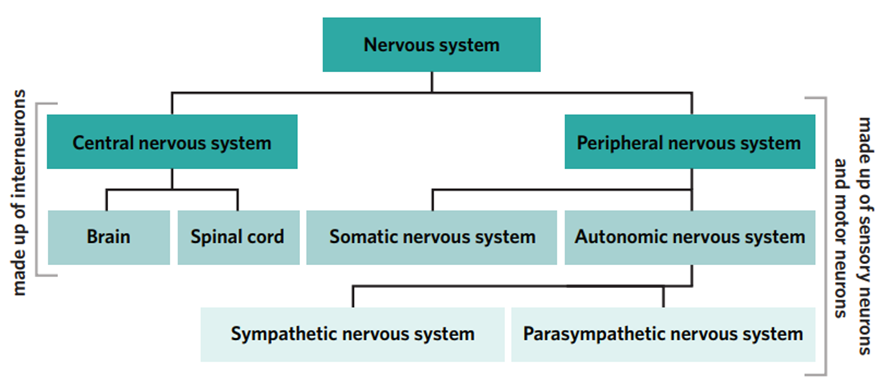
What is the sympathetic nervous system?
The sympathetic nervous system is a division of the autonomic nervous system that activates visceral muscles, organs and glands preparing the body to respond to a threat or stressor. It enables it to engage in high physical activity to confront a stressing situation.
What is the parasympathetic nervous system?
The parasympathetic nervous system is a division that maintains and returns the body to optimal and balanced functioning after experiencing heightened bodily arousal due to sympathetic responses, as well as maintaining homeostasis. The body would become depleted without this system as it helps to conserve energy.
What are neurons?
Neurons are the fundamental building blocks of the nervous system, specialized cells responsible for receiving and transmitting neural signals throughout the body.
What is a neuron structure?
Dendrites: Branch-like structures that receive signals from other neurons, transmitting information to the cell body.
Cell Body (Soma): Contains the nucleus and organelles, processing incoming signals and integrating information.
Axon: A long, slender projection that conducts electrical impulses away from the cell body to other neurons, muscles, or glands.
Synapses: Specialized junctions where neurons communicate with one another, releasing neurotransmitters that transmit signals across the synaptic gap.
Types of neurons found in nervous system
Motor neurons (efferent neurons) transmit motor signals from the CNS to effectors (muscles or glands), facilitating voluntary and involuntary movements.
Sensory neurons (afferent neurons) carry sensory information from peripheral receptors to the CNS, allowing the brain to process environmental stimuli.
Interneurons, serve as connectors or relays between sensory and motor neurons, facilitating communication within neural circuits. The central nervous system, including the spine and brain are made up of interneurons.
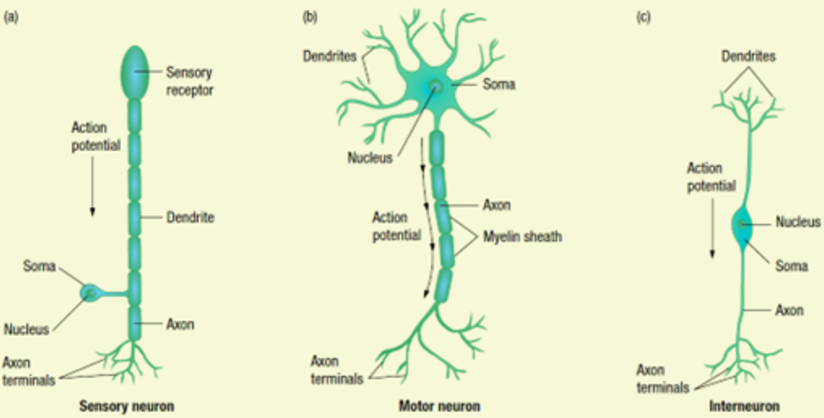
What is a conscious response
A conscious response refers to deliberate, voluntary actions initiated by the brain in response to sensory stimuli. This process engages both the central and peripheral nervous systems, particularly the somatic nervous system, to execute intentional movements.
What are sensory receptors
Sensory receptors are specialized nerve endings that detect internal sensations within the body and external stimuli from the environment, converting these stimuli into neural signals for processing
What is the general process of a conscious response?
A stimulus from the external environment is detected by sensory receptors in the body.
The sensory receptors convert the stimulus into an electrical signal (action potential).
This signal travels along sensory neurons (afferent pathways) toward the spinal cord and brain.
The sensory signal reaches the spinal cord and ascends to the brain, where it is processed in relevant areas
The brain formulates a response based on the processed information. This may involve evaluating and interpreting the significance and nature of the stimulus (whether it poses a threat).
Once a decision is made, the brain sends motor signals (efferent pathways) through motor neurons to the appropriate effectors (muscles or glands).
The motor neurons stimulate the target muscles to contract or relax, resulting in the desired action
Sensory feedback may be sent back to the CNS to inform the brain about the effectiveness of the response, allowing for adjustments in future reactions.
Give an example of a conscious response?
When a person’s hand comes into contact with cold water, sensory receptors in the skin detect the temperature change.
This cold sensation is transmitted to the CNS via afferent sensory pathways in the somatic nervous system, traveling to the spinal cord and then to the brain.
The brain processes this sensory information, resulting in a decision to increase the water temperature by turning on the hot tap.
This decision triggers motor neural messages to travel via efferent pathways from the CNS to the skeletal muscles, initiating movement toward the hot tap.
The skeletal muscles contract to pull the hand closer to the hot tap, thereby adjusting the water temperature.

What happens when there is damage to the spinal cord?
Injuries to the spinal cord can disrupt the transmission of neural messages, leading to significant sensory impairments (such as numbness or tingling) and motor deficits (including weakness or paralysis). Severe damage may result in complete loss of sensation and movement below the injury site, impacting overall bodily function.
What are unconscious responses
Unconscious responses are automatic and involuntary actions performed by the body without direct involvement or awareness of the brain. These responses are critical for maintaining physiological stability and reacting to environmental changes.
How to distinguish between unconscious and conscious responses?
The primary distinction lies in the level of brain engagement: conscious responses are initiated by the brain's decision-making processes, while unconscious responses occur autonomously, often bypassing the need for conscious thought. This does not imply that the brain is unaware of unconscious responses; rather, they operate outside conscious control.
Give examples of sympathetic unconscious responses
Heart rate increases to increase blood flow, enabling high levels of physical activity.
Breathing rate increases and lung airways expand to increase oxygenation, enabling high levels of physical activity.
Pupils dilate to allow lighter to enter the eyes, improving vision.
Adrenal glands secrete stress hormones, such as adrenaline, to energise the body.
Sweat glands are activated, increasing perspiration.
Digestion is inhibited to conserve energy required for high levels of physical activity.
Give examples of parasympathetic unconscious responses
The heart beats at a steady and regular rate that supports optimal and balanced functioning.
Lung airways constrict, enabling a steady and regular breathing rate.
Pupils constrict according to external light levels, allowing an appropriate amount of light to enter the eyes for adequate vision.
Adrenal glands do not secrete stress hormones, such as adrenaline, to allow the body to rest.
Sweat glands are regulated, controlling perspiration
What is the spinal reflex
The spinal reflex is an involuntary and automatic response to sensory stimuli, mediated by interneurons within the spinal cord, and occurs independently of the brain's direct involvement.
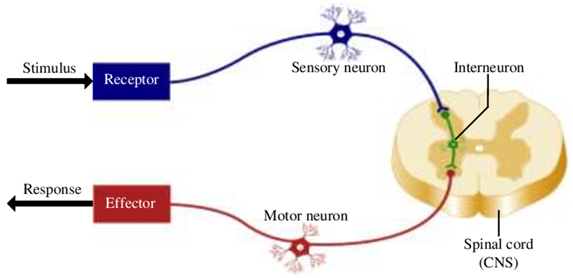
What is the general process of the spinal reflex
A stimulus is detected by sensory receptors in the skin or other body parts.
The sensory receptors convert the stimulus into an electrical signal (action potential). This signal travels along sensory neurons (afferent pathways) toward the spinal cord.
Upon reaching the spinal cord, the sensory neuron synapses with an interneuron (if present) or directly with a motor neuron. Interneurons serve as relay points and can process or modify the signal before transmitting it.
The motor neuron (efferent pathway) receives the signal from the interneuron or directly from the sensory neuron. The motor neuron transmits the motor signal to the appropriate skeletal muscles.
The motor neuron stimulates the target muscles to contract, resulting in an automatic motor response.
Although the reflex occurs independently of the brain, the sensory signal continues to travel to the brain for processing. The brain registers the sensory input after the reflex action has occurred, allowing for awareness of the stimulus and response.
Give an example of the spinal reflex.
A person touches an extremely hot pan. This painful sensation is detected by their sensory receptors and transmitted via sensory neural pathways to the spinal cord.
An interneuron in the spinal cord relays this sensory message from a sensory neuron to a motor neuron as a motor neural signal, initiating an unconscious motor response to quickly withdraw the hand from the extremely hot pan.
The motor message is transmitted via motor neurons to skeletal muscles, which carry out this unconscious motor response to the dangerous or harmful sensory stimulus as the person withdraws their hand from the extremely hot pan.
The sensory message continues to travel via afferent tracts in the spinal cord to the brain. Then, the brain independently registers the sensation that triggered the spinal reflex.
Explain the reflex arc.
The reflex arc is the neural pathway that facilitates the spinal reflex. It begins with sensory receptors detecting a stimulus, followed by transmission of sensory information to the spinal cord. In the spinal cord, interneurons process the signal and relay it to motor neurons, which then carry the response signal to the effector (muscle or gland).
How does the spinal reflex protect humans
The spinal reflex protects humans by enabling rapid, involuntary responses to potentially harmful stimuli, bypassing the brain to minimize delay. This immediate reaction helps prevent injury by allowing the body to respond before the brain processes the danger. The reflex arc's efficiency is crucial in situations like touching a hot surface or stepping on something sharp, where delayed reactions could lead to more serious harm.
Protection through Speed: By limiting the response time and not requiring the brain’s involvement, the spinal reflex reduces the potential for damage. For example, in a reflex arc, a pain stimulus (e.g., touching a hot surface) triggers the withdrawal reflex almost instantaneously.
Minimizing Damage: This quick reaction minimizes the time the body is exposed to the harmful stimulus, such as removing a hand from heat or pulling back from sharp objects, thereby reducing injury.
What is neural synapse
A neural synapse is the region between two neurons that allows for the transmission of signals. It involves the axon terminals of the presynaptic neuron, the synaptic gap (or cleft), and the dendrites of the postsynaptic neuron. This complex system is responsible for the chemical transfer of information from one neuron to another.
Define all key terms regarding the neural synapse.
Presynaptic neuron: The presynaptic neuron is the neuron that transmits signals by releasing neurotransmitters into the synaptic gap. It is responsible for initiating the communication process by converting an electrical impulse into a chemical signal. |
Axon terminals (terminal buttons): This is the ends of a neuron where neurotransmitters are stored in synaptic vesicles. When an action potential reaches the axon terminal, these neurotransmitters are released into the synaptic gap. |
Synaptic gap: The space between the presynaptic neurons and the post synaptic neuron. Despite being in close, the two neurons never physically touch. |
Postsynaptic neuron: This is the neuron that receives neurochemicals from the neural synapse through specialized receptor sites located on its dendrites, initiating either an excitatory or inhibitory response. |
Dendrites: They are branch-like extensions of the beginning of a neuron on which receptor sites are located. These structures increase the surface area available for receiving incoming signals from other neurons. |
Receptor sites: They are protein molecules on the dendrites of a neuron that receives neurochemicals and are specific to certain neurotransmitters, |
Neurochemicals: A chemical substance that transmit neural information within the nervous system. It is used by neurons to communicate with one another through the release of neurochemicals. |
Synaptic transmission: It is the chemical conveyance of neural information across a neural synapse. |
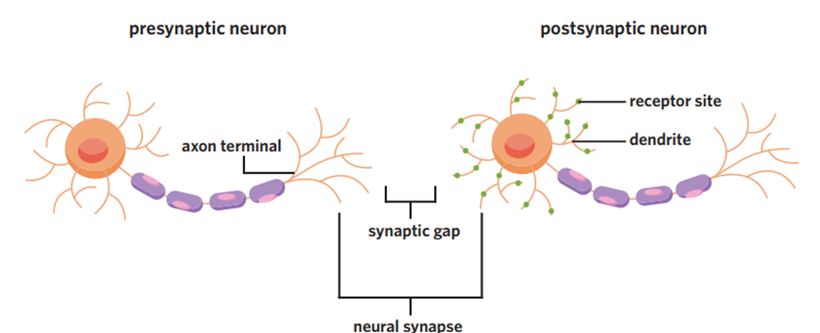
The process of synaptic transmission
1) Neurochemicals are produced and stored in the axon terminals of the presynaptic neurons |
2) When an action potential reaches the axon terminal, neurotransmitters are released into the synaptic gap. |
3) Neurotransmitters travel across the synaptic gap and bind to the receptor sites on the dendrites of the postsynaptic neuron. |
4) Depending on the type of neurotransmitter, the postsynaptic neuron is either excited or inhibited, altering its likelihood of firing an action potential. |
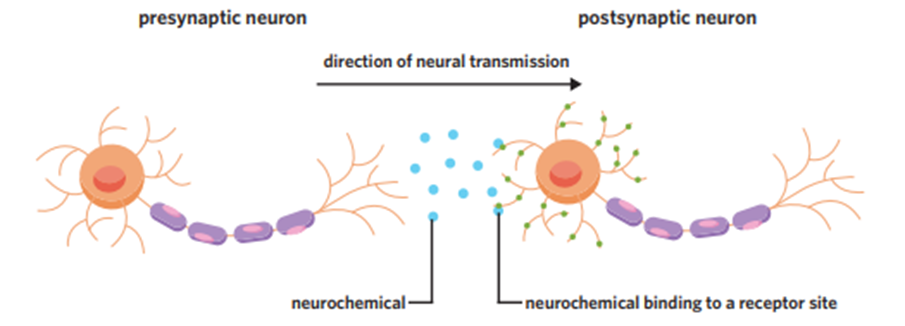
Explain lock and key process.
Each neurochemical has a distinct molecular structure that corresponds to a specific receptor site. A neurochemical can only bind to the corresponding site that matches its specific molecular structure. It cannot bind to the receptor sites of other neurochemicals because these receptor sites do not match its specific molecular structure. This ensures that only neurotransmitters with the correct shape can bind to a given receptor, preventing mismatched interactions
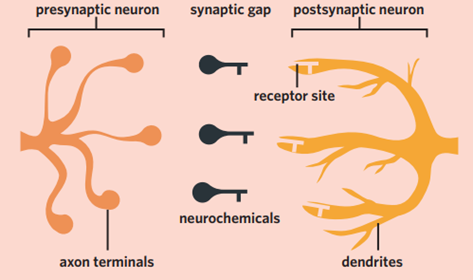
Neural transmission is an electrochemical process.
Neurochemicals bind to receptor sites and influence the postsynaptic neuron (chemical transmission) which becomes either more or less likely to fire an action potential (electrical transmission) which triggers the release of neurochemicals from the axon terminals of the presynaptic neuron, into the synaptic gap (chemical transmission). This electrochemical transmission progresses along the neural pathway, where signals are transmitted electrically within a neuron via action potentials and chemically between neurons through the release of neurotransmitters.
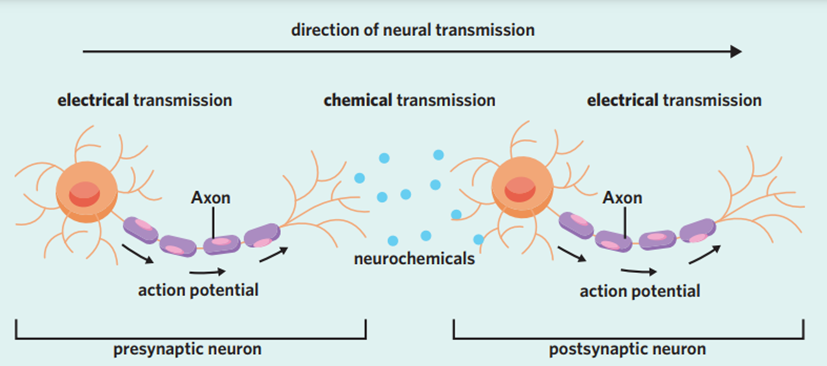
What is a neurotransmitter
Neurotransmitters are chemical molecules that influence one or two postsynaptic neurons. This type of neurochemical enables rapid communication between two neurons across the neural synapse.
What is reuptake
Reuptake refers to the process by which neurotransmitters that do not bind to receptor sites are absorbed back into the axon terminal of the presynaptic neuron. This process helps regulate neurotransmitter levels in the synapse and prevents overstimulation of the postsynaptic neuron.
What are the two types of neurotransmitters
1Excitatory neurotransmitters have an excitatory effect, increasing the likelihood of the postsynaptic neuron firing an action potential. This occurs when an excitatory neurotransmitter binds to a receptor site on the dendrites of the postsynaptic neuron. They enhance neural transmission along neural pathways by activating postsynaptic neurons.
2Inhibitory neurotransmitters have an inhibitory effect, decreasing the likelihood of the postsynaptic neuron firing an action potential. This occurs when an inhibitory neurotransmitter binds to a receptor site on the dendrites of the postsynaptic neuron. They suppress neural transmission from occurring along neural pathways by regulating the activation of postsynaptic neurons.
What is glutamate
It is the main excitatory neurotransmitter in the central nervous system and has an important role in learning and memory. The excitatory effects of glutamate help form and strengthen synaptic connections between neurons that are repeatedly activated during learning. These strong synaptic connections represent memories of what has been learnt and enables synaptic plasticity.
What is GABA
GABA (Gamma-Aminobutyric Acid) is the primary inhibitory neurotransmitter in the central nervous system, playing a crucial role in regulating and reducing postsynaptic activation in neural pathways to prevent excessive excitability in the brain. By counterbalancing excitatory neurotransmitters like glutamate, GABA helps reduce anxiety, a physiological and psychological response characterized by feelings of worry and apprehension, by inhibiting excitatory neural signals. Additionally, GABA prevents the uncontrolled firing of action potentials, making it essential for averting seizures and maintaining overall neural stability.
Explain the importance of inhibitory and excitatory neurotransmitters.
It is important to understand that both excitatory and inhibitory effects are important for optimal brain functioning. Postsynaptic neurons in neural pathways would fire uncontrollably without the inhibitory effects of GABA counterbalancing the excitatory effects of glutamate, potentially causing anxiety and seizures. Conversely, postsynaptic neurons in neural pathways would not be adequately stimulated and activated without the excitatory effects of glutamate counterbalancing the inhibitory effects of GABA, potentially causing learning and concentration difficulties, and mental exhaustion.
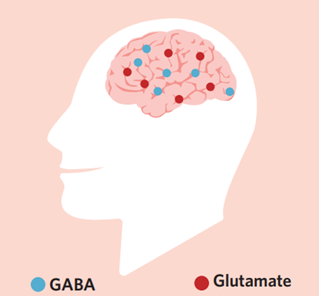
What is a neuromodulator?
Neuromodulators are chemical molecules that influence the activity of multiple postsynaptic neurons. This type of neurochemical modulates neural activity on a larger scale than neurotransmitter because neuromodulators are released into multiple neural synapses and consequently affect multiple postsynaptic neurons unlike neurotransmitters, which act at specific synapses, Therefore, neuromodulators, have a widespread modulatory effect which produce relatively long-lasting effects due to slower process.
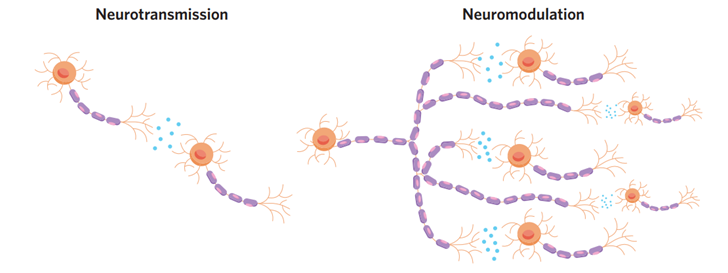
What do neuromodulators do
Responsiveness: Neuromodulators alter the responsiveness of receptor sites for specific neurotransmitters, thereby enhancing or diminishing the excitatory or inhibitory effects of those neurotransmitters.
Modulation of Release: Neuromodulators can influence both the quantity and timing of neurotransmitter release from the presynaptic neuron, thereby altering the dynamics of synaptic transmission and affecting overall neuronal communication.
Explain how neuromodulators affect the responsiveness of neurotransmitters
When a neuromodulator is released, it binds to specific receptors on the postsynaptic neuron that differ from those for traditional neurotransmitters, influencing the neuron's responsiveness to incoming signals.
This binding can enhance or reduce the likelihood of a response: if the neuromodulator increases receptor sensitivity, even a small amount of neurotransmitter can trigger a significant postsynaptic response, amplifying neural communication.
Conversely, a neuromodulator may decrease receptor sensitivity, leading to a diminished response when neurotransmitters bind to those receptors.
This modulation allows the nervous system to finely regulate and balance neural activity, ensuring that responses are appropriate to the physiological context.